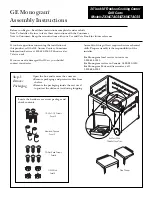
6
GB
r)
Sawing, cutting and abrasive actions create heat.
This may affect the workpiece and
power tool. ALWAYS monitor the heat level and in the event of excessive heat switch
off the power tool and allow to cool before restarting work. Some power tools depending
on design may be more quickly and effectively cooled by running at high speed without
load.
s)
The power tool will draw in dust through the vents on its body.
Excessive
accumulation of powdered metal may cause an electrical hazard and destroy the tool.
ALWAYS ensure the environment dust level is safe for the tool and ensure the vents are
not blocked.
t)
For mains-operated power tools, ensure the cable of the power tool is ALWAYS kept
behind the tool and never close to where the accessory or blade is operating.
u)
DO NOT reach under the workpiece, rest the workpiece on your body, or hold the
workpiece while working on it, as contact with the blade or accessory protruding
from the workpiece can result in serious injury.
v)
Anti-vibration gloves should be worn when operating power tools that produce
large amount of vibration, especially during long-term use.
w)
For power tools with a rotating mechanism and accessories ensure the operator is
not wearing clothes or gloves with frayed threads, cords etc. that could be
entangled in the rotating mechanism dragging the operator’s hand into the rotating
accessory causing injury.
ALWAYS wear tight itting work clothes, safety shoes.
Remove jewellery and secure long hair. NEVER wear fabric-based gloves that can
produce strands of material when operating this type of power tool.
x)
DO NOT allow sanding sheets to wear away on the sanding pad.
This will damage the
surface of the pad requiring replacement and may cause parts of the sanding sheet to ly
off the pad, causing operator injury.
y)
DO NOT touch the moving sanding sheet.
z)
Wire brush bristles are thrown by the brush even during ordinary operation.
DO NOT overstress the wires by applying excessive load to the brush. The wire bristles
can easily penetrate light clothing and skin.
Note:
The tool must ONLY be used for its intended purpose. Any use other than those
mentioned in this manual will be considered a case of misuse. The operator, and not the
manufacturer, shall be liable for any damage or injury resulting from such cases of misuse.
The manufacturer shall not be liable for any modiications made to the tool, nor for any
damage resulting from such modiications.
Battery Charger Safety
Use the battery charger correctly
• Refer to the section of this manual relating to use of the battery charger before attempting
to charge the battery.
• DO NOT attempt to use the charger with any batteries other than those supplied. Keep
your battery charger clean; foreign objects or dirt may cause a short or block air vents.
Failure to follow these instructions may cause overheating or ire
• If the supply cord is damaged, it must be replaced by the manufacturer, the service agent
or similarly qualiied persons in order to avoid a hazard
WARNING:
DO NOT attempt to recharge non-rechargeable batteries.
Battery Safety
WARNING
: Li-Ion batteries, if incorrectly used, stored or charged are a ire, burn and
explosion hazard.
• Keep the battery out of reach of children
•
ONLY charge Li-Ion batteries using the charger provided or designed speciically for your
product
•
ONLY use Li-Ion batteries provided with a product or speciically designed to be
compatible
• Allow batteries to cool for 15 minutes after charging or heavy use. Failure to follow these
instructions may cause overheating or ire
•
When not in use batteries should be stored at room temperature (approximately 20˚C)
• Ensure that battery contacts cannot accidentally short in storage. Keep batteries clean;
foreign objects or dirt may cause a short. Keep away from other metal objects, for
example paperclips, coins, keys, nails and screws
• Under abusive conditions, liquid may be ejected from the battery. This liquid may cause
skin irritation or burns. Avoid contact. If contact accidentally occurs, lush with water. If
liquid contacts eyes, seek medical help
• DO NOT open, disassemble, crush, heat above 60°C or incinerate. Do not dispose of in
ire or similar
PDF Compressor Pro
Summary of Contents for GCHD12
Page 2: ...F Compressor Pro ...
Page 125: ...63 F Compressor Pro ...
Page 126: ...F Compressor Pro ...
















































